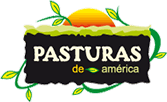Team Members:
![]()
Dr. M. J. Williams
![]()
Dr. Roy Pittman
![]()
Dr. Esteban A. Pizarro
![]()
Ing. Agr. Pedro Juan Caballero
![]()
Ing. Agr. L. E. Robledo
Trip Objectives:
1. Taxa to be collected: Arachis spp., particularly A. glabrata and A. lignosa.
2. Specific or general characteristics sought: Seed production, compatibility in mixtures, grazing tolerance, and flooding tolerance.
3. Use to be made of the germplasm collected: Development of improved annual and perennial Arachis cultivars for forage, turf and erosion control in subtropical regions of the world.
Summary
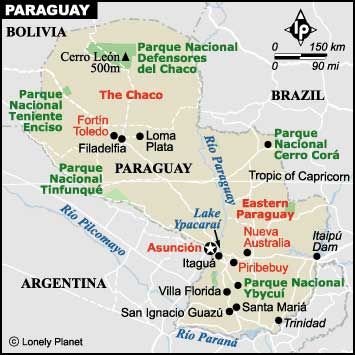
For the continuing benefit of the peoples of Paraguay and the United States, funding was secured from the Unites States Department of Agriculture, Agricultural Research Service, Plant Exchange Office (USDA, ARS, PEO) to further efforts in a cooperative systematic survey and collection of Arachis germplasm in Paraguay for forage and alternative uses.
Twenty-seven new accessions (collection numbers 970-997) were collected, and one accession (930) from the 2002 collection trip was recollected. Rhizomatous accessions found during the collection trip were of special interest because of the wide range of soil types and pH they occurred on.
Most of the material was collected in Concepción Department; only two collections were made in Amambay Department in spite of two and a half days worth of travel. Failure to find more material in Amambay, a department noted for its diversity of Arachis spp., should be interpreted with caution. Although it is hard to believe that the wild populations have not been impacted by the extensive agricultural development in the department, the extent of this impact should be investigated when more normal rainfall patterns have occurred.
Arachis is usually not a major component of the ecosystem, and plants can be easily overlooked when they are not in flower due to drought, as had occurred in 2003. Additionally deteriorating road conditions due to heavy rains, curtailed planned travels in the department. One of the trip goals, while in Concepción Department, was to better determine the extent of the A. glabrata (961) found on the calcareous soils of the department in2002. We were able to visit one estancia (>14,000 ha) in this area and collected more material from two sites (983-984).
The estancia manager said he had observed this material over the remaining 5000 ha of native vegetation and that cattle almost exclusively grazed the A. glabrata during the mid summer months (November - December). Additional collections of similar A. glabrata at sites more than 10 km north and south suggests this material is one of the largest populations of wild Arachis in the world. Of special note, was the interest expressed by farmers and ranchers for the "new legume" Arachis for livestock and farming systems. These requests need to be addressed in future collection trips by allowing time to make presentations (cooperative/agricultural schools) showing the cooperative efforts and benefits to Paraguay and the USA of germplasm collection, preservation, and/or use.
Material collected during this trip will identified with the collector's identification initials of CbRbWiPmPz.
Travel Details
May 27

International participants arrived in Asunción and were met by Paraguayan team members. Additional trip supplies were secured and arrangements made to meet with Ing. Agr. Victor Santander of the Ministerio de Agricultura y Ganadería the following morning to discuss permits and travel plans.
May 28
Team members met with Ing. Agr. Victor Santander and briefed him on the status of the material from the previous collection trip.
These discussions included the identification of plant material from the previous trip by Prof. A. Krapovickas of the Instituto de Botánica del Nordeste, Corrientes, Argentina, and plant increase efforts with the material conducted by Dr. Pittman at the Plant Genetic Resources Unit in Griffin, GA. Dr. Williams also described her preliminary field evaluation of selected accessions from the previous trip currently underway in regional trials at seven cooperating sites in the US.
Additionally, Dr. Pittman and Ing. Agr. Santander discussed the seed increase/regeneration efforts being made to preserve Paraguayan A. hypogeae land race material that had been collected previously in a cooperative effort with Japan. Logistics of the current trip were then discussed.
Following this visit, the team went to the Ministerio del Medio Ambiente and met with Ing. Agr. José Fassardi, Cabinet Chief, and discussed collection permitting. In the afternoon, team members departed for Concepción.
May 29





The plan was to continue collection efforts in northeastern Concepción Department that were curtailed in the previous trip due to wet road conditions.
En route to Paso Barreto, we revisited the site (23o 23.479'S 57o 25.267'W), where accession 950 (A. nov Valls et al.) was collected in 2002, and the status of the population was checked. The population (95003) was relocated in the roadside, but unlike last year, none of the plants were observed in flower due to the extended late summer drought. Due to the drought conditions, an initial collection protocol of 5 km sampling frequency or flower/plants observed from the vehicle was established.
The first collection was made northeast of the Ao. Trementina bridge on the road from Paso Barreto to Bella Vista. At that site, A. paraguariensis (9701) was collected in the roadside which went through a small stand of trees and shrubs at that point. The surrounding vegetation was dry native savanna with small trees and palms which was being grazed. In similar habitat further along that road, accessions 971, another A. paraguariensis, was collected in a pasture area adjacent to the road. At both of these sites, individual plants consisted of a single erect stem and the populations were small (<10 plants).
The 971 plants were located in protected areas adjacent to shrubs or bunch grasses. South of Estancia Yu Apua, on the road to Bella Vista, a small population of A. glabrata (972) was located growing out of the road shoulder. This population was representative of much of the A. glabrata and other species found in this and the previous trip. Plants were actually doing better in the road shoulder, despite unrestricted grazing and vehicular traffic, than in adjacent pasture land due to reduced competition from surrounding vegetation. At the next stop, another A. paraguariensis (973) was located.
Due to the distance that still remained Bella Vista and the rather abundant nature of Arachis in the area, collection protocol was changed to 10 km intervals between stops unless plants were observed en route, and this protocol remained in effect for the remainder of the trip. At the next stop, 20 km north of Estancia Yu Apua, a small population of A. glabrata (974) and an Arachis spp. (975, possibly seedlings of 974 although these populations did not appear intermixed) was collected. Both plants had unusually brittle leaflets.
A short distance up the road, the best population of Arachis observed that day was found in the fill dirt around bridge. These A. glabrata (976) plants were actually flowering due to the better moisture conditions. This accession also had hard feeling leaflets. Accession 977 was another A. paraguariensis, possibly all seedlings, and was located in native dry savanna used as pasture. Accession 978 and 979, were A. paraguariensis and A. glabrata, respectively, and were located in the road verge around Estancia Trementina.
The final collection site also yielded two accessions, 980 and 981, A. paraguariensis and A. glabrata, respectively. These plants were growing mixed with Paspalum spp., possibly notatum in the shade under some large trees on the roadside just south of the headquarters of Estancia San Liberato. The team turned around and returned to Concepción at this point which was about 140 km away. Plans were made to return to this point at a later date during this trip and continue on the road to Bella Vista which was still about 100 km away.
May 30





Arrangements had been made this day to visit Estancia Bello Horizonte, owned by Ing. Agr. Maximo Codas, about 100 km northwest of Concepción on the road to Vella Mi. While on the way, just south of Paso Horqueta accession 982, the only A. hypogaea collected this trip, was found. Freshly dug peanut plants from a local garden were observed drying next to a house.
The property owner gave us permission to take a few plants, which contained tan or red seed of the valencia type. The leaflets of the plants exhibited some leafspot, but the pods were essentially free of disease signs. We proceeded north, crossing the Rio Aquidaban, and stopped at the site (22o 55.571'S 57o 21.997W) where large areas of A. microsperma (962) were obseved in 2002. As with the other sites revisited in 2003, the plants were present but suffering from drought (96203). At Estancia Bello Horizonte headquarters, we turned east into the estancia.
This estancia consists of about 14,000 ha of which 5000 ha remains in native vegetation. Most of the soils on this estancia are calcareous, and we were interested to see if the A. glabrata (961) population we observed in a similar soil type north of this estancia could be found on this site. Before we met up with the estancia manager, we stopped a few kilometers east of the public road and found accession 983, an A. glabrata that was similar to 961.
The plants occurred in a black sandy soil with football-sized or larger rocks. The accompanying vegetation was predominately Imperata braziliensis and Setaria geniculata and various legumes such as Tefrosia sp. and two species of Mimosa. The population at this site was extensive and occupied an area of at least 5 ha. At this site, population density was estimated to be about 30 plants per square meter based on replicated (n=7) 0.25-m quadrat counts.
We continued east through the estancia and stopped several times to check for Arachis. We found similar A. glabrata at all sites where native vegetation remained. We met up with the manager who said that he had observed this type of Arachis over all the native vegetation areas, and he said the cattle almost exclusively grazed the Arachis during the mid summer months (November and December).
The manager took us to a native range site (984) of scrub trees, Imperata, and A. glabrata with a population density similar to the first site we observed on the ranch. An adjacent field had recently been converted from similar native vegetation to Brachiaria by herbicide application, plowing, and seeding.
The stand was being grazed the first time after establishment, and we could still find A. glabrata in the sites were the grass stand was poor. Long term persistence of the Arachis under increasing pressure from the Brachiaria is questionable. After that collection, we thanked the estancia manager and returned back to Concepción.
May 31





We headed back north west on the road to Vella Mi to try to better document the range of the A. glabrata on the calcareous soils in that area. Approximately 3 km north of Colonia San Alfredo, we stopped and found a large population of A. glabrata that looked similar to the material collected the day before. Interestingly, the plant material at this location was heavily infested with spider mites, so much so that the webs covered much of the ground surface.
Previously, spider mite damage had been noted on many of the Arachis collections made during this trip, but the damage was limited to some yellowed foliage. An estancia employee, who stopped to check on our activities, said the field had been planted to B. decumbens several years previously and had been heavily grazed the past two years due to drought conditions.
Persistence of the Arachis material with B. decumbens suggests this might be a better species to plant when native areas are being converted to improved pastureland, than some of the newer Brachiaria materials. Cattle would benefit both from the higher productivity of the improved grass and the nutritive value of the Arachis remaining in the sward. We continued on the Vella Mi road north west of Estancia Maria Auxiliadora into the cerros.
This was part the same area that yielded accession 961 in 2002 but was several kilometers southeast of that site. We readily found A. glabrata (985) at this site also. We proceeded west north west through the cerros stopping at 10 km intervals. We failed to find Arachis one site, but it was heavily timbered. At the next site just west of Ao. Primavera, we again found an A. glabrata (986) that appeared similar to the previous collections. The population at this site was not as abundant as the previous sites, possibly due to very heavy grazing pressure near the road.
The stand appeared to improve as you moved away from the road. We continued west northwest on the newer portion of the Vella Mi road that follows the power lines. The topography changed from hills to a flat landscape and the vegetation took on the appearance of the Chaco.
At the next scheduled stop we failed to find any Arachis, but as we proceeded further north, Ing. Agr. P.J. Caballero noticed an Arachis flower. Their was one plant (987) with a taproot with multiple stemmed crown and another smaller plant, possibly a seedling.
They were tentatively identified as being in the section Procombentes. We continued on the road to within 10 km of Vella Mi without finding any further material. On the return trip, Ing. Agr. P.J. Caballero spotted an additional group of plants (988) similar to the 987 collection. Again these were tentatively identified in the section Procombentes. After that stop we did not observe any further Arachis on the return trip.
June 1




We headed northeast of Concepción to finish the last of the road from Paso Barreto to Bella Vista. It took almost four hours to reach Estancia San Liberato, where we had stopped on the previous day. North of Estancia San Liberato we passed through some native grassland areas that had almost no trees, but failed to find any Arachis, possibly due to very heavy grass cover.
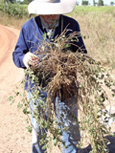
At our second stop, we found a large population of an unidentified Arachis sp. (989). The plants were of moderate size on the roadside, but became quite small and appressed to the ground in the adjoining pasture area. The population extended over a fairly wide area (2 ha). The plants had taproots and crown areas.
There was some discussion as to what section they belonged, Procombentes (horizontal pegs) or Arachis (vertical pegs), but this could not be easily determined due to the absence of pegs. We stopped just south of Colonia Sgt. José Felix Lopez, but the area was marshy and there were no Arachis plants present. North east of town, Dr. R. Pittman observed a very large Arachis plant on the side of the road. His initial impression was that it was an annual member of the section Arachis, but no seed were present.
The plant was extremely large with multiple branches that extended over a meter in length (990). A second plant was found, although not as having as many stems, it did have one stem that extended for more than a meter in length from the crown. These plants were tentatively identified as A. Hoehnei, which has been reported to occur in this general area. In addition to these plants, two additional species were found, another A. paraguariensis (991) and another A. sp. (992) which had more oval leaves than 991, an orange flower, and a taproot. A similar plant with a flower (993) was collected at one of the stops east of Colonia Sgt. José Felix Lopez.
This population was larger, consisting of about 20 plants. At the next stop, a small A. paraguariensis was found but not collected. South east of Estancia Larenzo on the road to Bella Vista, another unidentified plant (994) that resembled 992 was also collected. The final collection spot of the day, just outside Bella Vista, yielded and extensive population of a very small leaved A. glabrata (995). The small size of the leaflets may have been due to heavy grazing pressure apparent in the cut over former woodland.
After that collection, we returned to Concepción more than 200 km away via Rt. 3 and Rt. 5.
June 2




We moved a distance of 200 km from Concepción to Ciudad Pedro Juan Caballero in Amambay Department. Numerous Arachis spp. including A. major, A. guaranitica, and A. tuberosa have been found in this department possibly due to the variable topography which ranges from the Cordillerra del Amambay on the eastern border with Brazil, west into the mountain/valley of the Cerro Cora area, and further west into the rolling hills that gradually merge into the savanna areas of eastern Concepción Department.
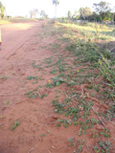
In recent years, most of the native vegetation from the Cerro Cora area eastward to the city has been converted to crop or improved pastureland. In the afternoon, we traveled north of the town on the road that parallels the Brazilian border in the general direction of Cololonia Estrella.
The leveler ground north of the city was planted to wheat and corn, while the more hilly areas were planted to Brachiaria pastures. From Estancia Estrella, we took a generally westwardly direction until we ran out of public road. The GPS indicated that we were about 10 km east of the Bella Vista road where we had ended our trip the previous day.
During this whole trip we failed to find any Arachis. We returned to the city and went southeast of town toward Fortuna. We stopped north of Fortuna and spoke to a local rancher who was aware of the forage value of Arachis from a recent TV program from Brazil talking about A. pintoi. He said he and a group of other ranchers were trying to import some seed from Brazil. He said he had seen some native Arachis in the campo, but did not have any on his place.
On the outskirts of Fortuna, Ing. Agr. Caballero, spotted fairly large population of A. glabrata (996) escaping from the Brachiaria growing in the adjacent pasture.
We proceeded south another 10 or 15 km without finding another Arachis as the road went up into the foot hills of the cordillera and it got too dark to see.
June 3





It was raining this morning, and although the rain was welcome for the crops and pastures, wet road greatly increase travel time. We went back west along Rt. 5 until just east of the Parque Nacional Cerra Cora. We turned south onto the cobble road heading to Loreto.
At the first stop, we located a population of A. glabrata (997) in a poor Brachiaria stand on the east side of the road. We proceeded south and east on the road as it changed from cobble to dirt. Most of the native vegetation, which had been timber, had been cleared to plant improved pasture grasses.
We did not find any more Arachis on this road which ended at some private land which bordered the Rio Ypané or on the northern swing we took through the western side of the park into the Cordillera del Amambay.
It rained off and on all day.
June 4




The goal was to drive south along the frontier road toward the town of Capitán Bado and head southwest toward Rt. 11. It had been raining all night and the road was very wet. Just south of the ciudad, the country side was all wheat and corn fields. The more rolling areas were planted to Brachiaria.

After four hours of driving, the road conditions did not improve. We made it as far south as Colonia Nueva Independcia before we were told the road was closed due to a stuck vehicle and we turned around and headed back north. We had stopped every 10 km going south but had observed no Arachis spp. Failure to find any more than two accessions of A. glabrata, in a Department noted for its diversity of Arachis spp., should be interpreted with caution.
Although it is hard to believe that the wild populations have not been impacted by the extensive agricultural development in the department, the extent of this impact should be investigated when more normal rainfall patterns have occurred. Arachis is usually not a major component of the ecosystem, and plants can be easily overlooked when they are not in flower.
June 5




This was scheduled for a travel day to return to Asunción, but due to the aborted collecting trip the previous day, we decided to travel south through Col. Oviedo to San Salvador in Guairá Department to recollect accession 930, which had died during shipment to the US the previous year.
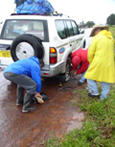
We arrived in the San Salvador area around 3:00 pm and easily relocated the population on the causeway between San Salvador and Borja. Although the population was showing drought stress (93003), it was still abundant on both sides of the road.
The identification of this material still remains in question, but its potential as a turf or ornamental selection cannot be over emphasized. Because it is found on a causeway and not in the adjacent marsh area, we knew it was not the original site for the material.
Towns people in Borja directed us to a large excavation area (>4 ha) that was the source of at least some of the soil used to build the causeway four years ago. We checked all around the excavation, but could find no Arachis plants. It is possible that all of the original site was dug up and moved during the construction of the causeway. After collecting more material, we headed back to Asunción and arrived about 8:00 pm.
June 6-8


The soil samples were processed for soil texture determination and pH. Arrangements were made for complete soil analysis to be conducted at Ministerio de Agricultura y Ganadería.
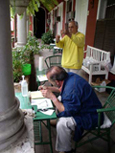
The collection was inspected for the phytosanitary certificate and divided so that a portion of material can be maintained in a germplasm nursery in Paraguay.
The trip report was written and translated and trip photographs organized.
June 9
Team members met with Ing. Agr. Victor Santander of the Ministerio de Agricultura y Ganadería and Ing. Agr. José Fassardi, Jefe de Gabinete del Ministerio del Medio Ambiente.
A presentation was made about the trip report (a Spanish and English version of the trip report along with photographs on CD was left).
Additionally, the need in future trips to allow time to make presentations showing the cooperative efforts and benefits to Paraguay and the USA of germplasm collection, preservation, and/or use that were requested at numerous stops (cooperatives/ agricultural schools) was discussed.
Acknowledgements
The participants wish to express their thanks to Ing. Agr. Victor Santander of the Ministerio de Agricultura y Ganadería, Ing. Agr. José Fassardi, Jefe de Gabinete del Ministerio del Medio Ambiente, and Karen Williams of the USDA, ARS, Plant Exchange Office for their considerable assistance with this trip.

